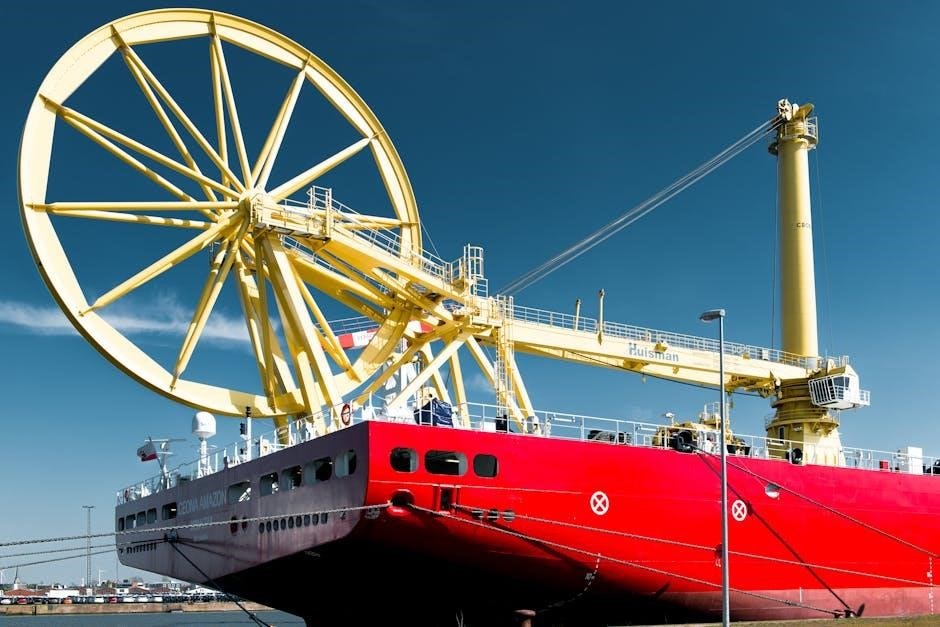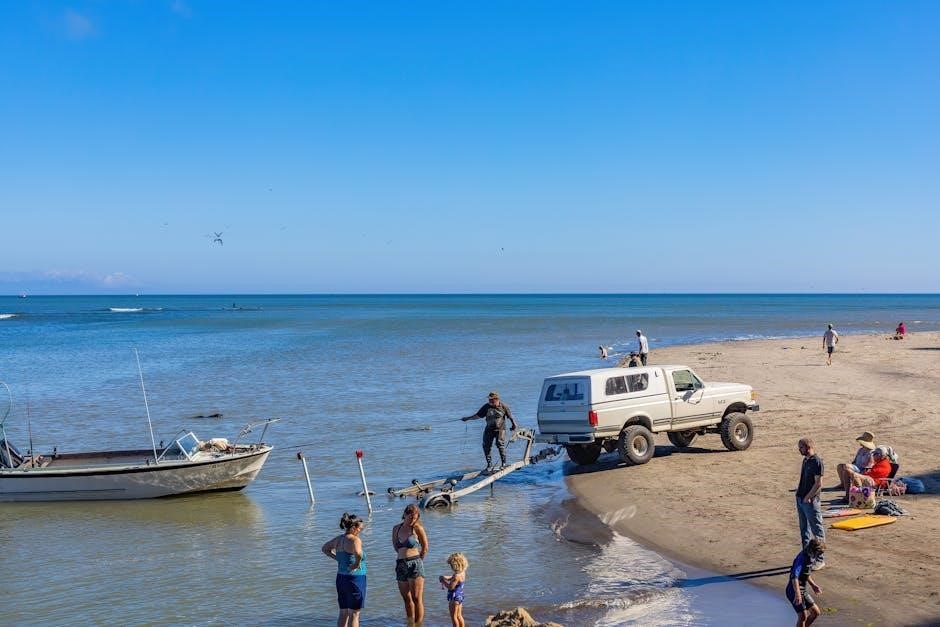Safely and efficiently loading your pontoon boat onto a trailer requires understanding key steps and considerations. This guide provides essential tips and techniques, ensuring a smooth and secure process every time you prepare to transport your boat on land.
Pre-Loading Checklist
Before you even think about backing your trailer down the ramp, a thorough pre-loading checklist is essential for a safe and efficient experience. First, check the tow vehicle. Ensure it’s capable of handling the combined weight of the pontoon boat and trailer. Verify all lights are functioning correctly – brake lights, turn signals, and running lights are crucial for visibility on the road.
Next, prepare the trailer itself. Inspect the tires for proper inflation and any signs of wear or damage. Make sure the winch is in good working order, with a secure strap and a smoothly operating mechanism. Check the bunks or rollers, ensuring they are properly aligned and in good condition to support the boat’s hull.
Gather all necessary equipment, including tie-down straps, safety chains, and a boat hook. The boat hook can be invaluable for maneuvering the pontoon boat into position, especially in windy conditions. Finally, ensure the boat is clear of any loose items that could shift during transport. Remove any unnecessary gear, coolers, or personal belongings to minimize potential hazards.
Choosing the Right Trailer
Selecting the correct trailer for your pontoon boat is paramount for safe and stress-free transportation. The trailer’s weight capacity must exceed the combined weight of your pontoon boat, motor, and any gear you typically carry. Overloading a trailer can lead to serious accidents and damage to both the boat and the trailer.
Consider the trailer’s construction and materials. Look for a sturdy frame, preferably made of galvanized steel or aluminum, to resist corrosion, especially if you boat in saltwater environments. The trailer should also have adequate support, with properly positioned bunks or rollers that conform to the shape of your pontoon boat’s pontoons.
Easy-load boat trailers are equipped with guides and rails that help you get a perfect load every time. These guides assist in centering the boat during loading, reducing the need for constant adjustments. Other important features include a reliable winch, functioning lights, and properly sized tires. Investing in a high-quality trailer specifically designed for pontoon boats is a worthwhile investment for the safety and longevity of your boating experience.
Assessing Weather Conditions
Before attempting to load your pontoon boat onto a trailer, carefully assess the prevailing weather conditions. Wind, in particular, can significantly complicate the loading process, making it difficult to align the boat properly and control its movement. High winds can push the boat sideways, creating a challenging situation, especially at crowded boat ramps.
Consider postponing your loading if strong winds are present. If loading is unavoidable, try to use the wind to your advantage. Position the trailer and boat in such a way that the wind assists in guiding the boat towards the trailer. Be extra cautious and patient, and have a helper on hand to provide additional guidance and support.

Rain can also make the boat ramp slippery, increasing the risk of accidents. Wear appropriate footwear with good traction, and take extra care when walking around the ramp. Avoid loading in severe weather conditions such as thunderstorms or heavy fog, as these can create hazardous situations. Always prioritize safety and exercise good judgment when deciding whether or not to load your pontoon boat.
Positioning the Trailer at the Ramp
Properly positioning your trailer at the boat ramp is crucial for a smooth and efficient pontoon boat loading process. Begin by assessing the ramp’s angle and depth to determine the optimal spot for your trailer. The goal is to submerge the trailer bunks or rollers just enough to allow the boat to float on easily, without submerging the trailer too deeply.
Avoid backing the trailer in too far, as this can make it difficult to align the boat correctly. Conversely, not backing in far enough can prevent the boat from floating freely onto the trailer. A good rule of thumb is to keep the trailer just under the surface of the water. Take your time and make small adjustments as needed to find the sweet spot.
Consider the presence of other boaters and ensure you are not blocking the ramp or impeding their access. Be mindful of the wind direction and potential currents, as these can affect the boat’s movement and make it harder to align with the trailer; A well-positioned trailer sets the stage for a safe and straightforward loading experience.
Shallow Water Loading Technique
The shallow water loading technique is particularly useful for pontoon boats, minimizing the risk of damage and simplifying the loading process. This method involves positioning the trailer so that the top of the bunks or rollers are just submerged, allowing the boat to be guided onto the trailer with minimal submersion.
Begin by slowly approaching the trailer, ensuring the boat is aligned as straight as possible. Use a boat hook to gently guide the pontoon onto the trailer, making small adjustments as needed. This technique reduces the need to power the boat onto the trailer, preventing potential damage to the pontoons or trailer components.
Communication between the driver and a spotter is essential during this process. The spotter can provide valuable feedback on alignment and assist with guiding the boat. Once the boat is partially on the trailer, use the winch to slowly pull it into its final position. This method is especially effective in windy conditions or when dealing with slippery ramps, providing greater control and stability throughout the loading process.
Using Guide Rails Effectively
Guide rails are invaluable tools for simplifying the pontoon boat loading process, especially for those with less experience or in challenging conditions. These rails help align the boat correctly onto the trailer, reducing the need for constant adjustments and minimizing the risk of misalignment.
To use guide rails effectively, position the trailer at the ramp so that the rails are partially submerged. As you approach the trailer, steer the pontoon boat between the guide rails. The rails will naturally center the boat, ensuring it lines up properly with the bunks or rollers. This is particularly helpful in windy conditions where the boat might drift sideways.
Ensure the guide rails are properly adjusted to match the width of your pontoon boat. Overly wide or narrow rails can be ineffective or even cause damage. Regularly inspect the guide rails for any damage or wear, replacing them as needed to maintain their effectiveness. With well-maintained and properly adjusted guide rails, loading your pontoon boat becomes a much smoother and more efficient process.
Winch Operation
The winch is a critical component for safely loading a pontoon boat onto a trailer. It provides the necessary force to pull the boat fully onto the trailer bunks or rollers. Proper winch operation is essential to avoid damage to the boat or trailer, and to ensure a secure fit for transport.
Begin by attaching the winch strap or cable to the boat’s bow eye. Ensure the connection is secure and that the strap is not frayed or damaged. Slowly crank the winch, guiding the boat smoothly onto the trailer. Avoid jerky movements, which can cause the boat to shift unexpectedly.
As the boat moves onto the trailer, periodically check its alignment. If necessary, make minor adjustments to the steering to keep the boat centered. Once the boat is fully on the trailer, continue cranking the winch until the bow is snug against the bow stop. Secure the winch locking mechanism to prevent any slippage during transport. Regularly inspect the winch for wear and tear, lubricating moving parts to ensure smooth operation and prolong its lifespan.

Securing the Bow
Securing the bow of your pontoon boat to the trailer is a critical safety measure. This step prevents the boat from shifting forward during transit, especially during sudden stops or rough road conditions. A properly secured bow ensures stability and minimizes the risk of damage to both the boat and the trailer.
Begin by ensuring the winch strap is tightly connected to the bow eye and the winch is locked. Next, use a separate bow safety chain or cable to provide an additional layer of security. Attach the safety chain from the trailer to the boat’s bow eye, crisscrossing the chain for maximum strength.
Inspect the bow stop on the trailer to ensure it is in good condition and properly positioned to support the bow of the pontoon. The bow should rest firmly against the bow stop, preventing any movement. Regularly check the winch strap and safety chain for wear and tear, replacing them as needed to maintain optimal security. A well-secured bow provides peace of mind, knowing your boat is safe and stable during transport.
Strapping Down the Boat’s Rear
Securing the rear of your pontoon boat to the trailer is just as vital as securing the bow. This prevents the boat from bouncing or shifting sideways during transport, especially when encountering bumps or windy conditions. Properly strapping down the rear ensures the entire boat remains stable and centered on the trailer, minimizing potential damage.
Use high-quality tie-down straps designed for marine use. These straps are typically made from durable, weather-resistant materials that can withstand the elements and heavy loads. Position the straps over the pontoons or designated attachment points on the boat’s rear, ensuring they are evenly distributed to balance the load.

Secure the straps to the trailer frame, using sturdy D-rings or designated strap attachment points. Tighten the straps firmly, ensuring there is no slack and the boat is snug against the trailer bunks. Avoid overtightening, which can damage the boat or straps. Regularly inspect the straps for signs of wear, such as fraying or tears, and replace them as needed to maintain their effectiveness. Properly secured rear straps provide added stability and peace of mind during transport.
Checking Alignment on the Trailer
Before hauling your pontoon boat, verifying its alignment on the trailer is crucial for safe transport. Misalignment can lead to uneven weight distribution, causing handling problems and potential damage to the boat or trailer. Ensure the boat is centered lengthwise, with equal spacing on both sides between the pontoons and trailer frame.
Visually inspect the boat from the front and rear, noting any deviations from the centerline. Use guide rails, if equipped, to aid in centering the boat. If the boat is off-center, carefully adjust its position by slightly backing the trailer into the water and using a boat hook to nudge the boat into alignment. Alternatively, winch the boat further onto the trailer, making minor adjustments as needed.
Double-check that the boat is resting evenly on the bunks or rollers, with no excessive pressure points. Confirm that all straps and tie-downs are properly secured and not pulling the boat out of alignment. A well-aligned boat ensures balanced weight distribution, reducing the risk of swaying or instability during transport.
Safety Chains Attachment
Attaching safety chains is a non-negotiable step in securing your pontoon boat trailer, providing a vital backup in case of coupler failure. These chains connect the trailer to the tow vehicle, preventing complete separation and potential accidents. Always cross the safety chains under the trailer tongue, creating a cradle effect that can catch the tongue if it detaches.
Ensure the chains are long enough to allow for turns but short enough to prevent dragging on the ground. Attach the chains to the designated safety chain loops on the tow vehicle’s hitch receiver. Use appropriately sized S-hooks or quick links to connect the chains securely. Avoid twisting or kinking the chains, as this can weaken their strength.
Inspect the chains regularly for signs of wear, rust, or damage. Replace any chains that are compromised. Remember, safety chains are not a substitute for a properly functioning coupler but rather an essential layer of protection. Before each trip, double-check that the safety chains are securely attached and in good condition, ensuring a safer journey for you and other drivers on the road.
Dealing with Windy Conditions
Loading a pontoon boat onto a trailer in windy conditions presents a unique challenge, demanding extra caution and strategic adjustments. Wind can push the boat off course, making alignment difficult and potentially causing damage. Begin by assessing the wind direction and strength. If possible, position the trailer so the boat is pushed towards it rather than away.
Employ a spotter to help guide the boat and communicate with the driver. Use boat hooks to maintain control and prevent the boat from drifting. Keep the trailer shallower than usual, reducing the boat’s exposure to the wind. Consider using the dock as a windbreak, if available, to minimize the wind’s impact during loading.
If the wind is too strong, it may be best to postpone loading until conditions improve. Safety should always be the top priority. When winching, apply steady, controlled pressure to avoid sudden movements caused by gusts of wind. Double-check all straps and tie-downs to ensure they are securely fastened, compensating for the added stress from the wind. Patience and careful execution are key to successfully loading a pontoon boat in windy conditions.
Post-Loading Inspection

After loading your pontoon boat onto the trailer, a thorough post-loading inspection is crucial to ensure a safe and secure transport. Begin by double-checking all tie-down straps, making sure they are properly tightened and secured to both the boat and the trailer. Inspect the winch cable or strap for any signs of wear or damage, and ensure it is firmly attached to the bow eye.
Verify that the safety chains are correctly connected from the trailer to the boat’s bow eye, providing an additional layer of security. Check the alignment of the boat on the trailer, ensuring it is centered and not leaning to one side. Examine the trailer lights to confirm they are functioning correctly, including brake lights, turn signals, and running lights.
Inspect the trailer tires for proper inflation and any signs of damage. Ensure that the boat motor is properly secured and tilted in the correct position for transport. Finally, take a walk around the entire setup, looking for anything that may have been overlooked. Addressing any issues before hitting the road can prevent accidents and ensure a worry-free journey.


